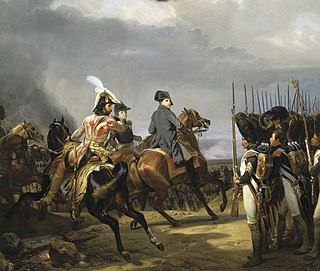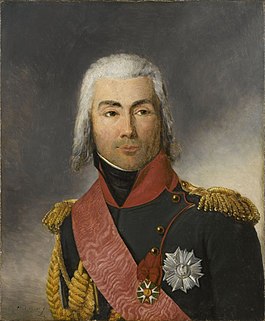
The Battle of Sehested was fought between Danish and Russian-Prussian-British troops at Sehested on 10 December 1813 during the War of the Sixth Coalition.

The Battle of Teugen-Hausen or the Battle of Thann was an engagement that occurred during the War of the Fifth Coalition, part of the Napoleonic Wars. The battle was fought on 19 April 1809 between the French III Corps led by Marshal Louis-Nicolas Davout and the Austrian III Armeekorps commanded by Prince Friedrich Franz Xaver of Hohenzollern-Hechingen. The French won a hard-fought victory over their opponents when the Austrians withdrew that evening. The site of the battle is a wooded height approximately halfway between the villages of Teugn and Hausen in Lower Bavaria, part of modern-day Germany.
The following units and commanders fought in the Battle of Eylau of the Napoleonic Wars.
This is an order of battle of the French and German Armies at the beginning of the Franco-Prussian War in 1870.

The Battle of Lübeck took place on 6 November 1806 in Lübeck, Germany between soldiers of the Kingdom of Prussia led by Gebhard Leberecht von Blücher, who were retreating from defeat at the Battle of Jena–Auerstedt, and troops of the First French Empire under Marshals Murat, Bernadotte, and Soult, who were pursuing them. In this War of the Fourth Coalition action, the French inflicted a severe defeat on the Prussians, driving them from the neutral city. Lübeck is an old Baltic Sea port approximately 50 kilometres (31 mi) northeast of Hamburg.

The Austro-Polish War or Polish-Austrian War was a part of the War of the Fifth Coalition in 1809. In this war, Polish forces of the Napoleon-allied Duchy of Warsaw and assisted by forces of the Kingdom of Saxony, fought against the Austrian Empire. By May, the Russian Empire joined against Austria. Polish troops withstood the Austrian attack on Warsaw defeating them at Raszyn, then abandoned Warsaw in order to reconquer parts of pre-partition Poland including Kraków and Lwów, forcing the Austrians to abandon Warsaw in futile pursuit.

The Armée d'Orient was the French military force gathered by the French Directory to send on the expedition to Egypt in 1798. The expedition had the intention of barring Great Britain's route to its colonies in India and was put under the command of Napoleon Bonaparte. Also known as Battle of Orient.

In the Battle of Hohenlinden on 3 December 1800, a French army commanded by Jean Victor Marie Moreau decisively defeated the army of Habsburg Austria led by Archduke John. The first action of the campaign was the Battle of Ampfing, two days earlier. After Hohenlinden there was a series of rearguard clashes beginning on 9 December at Rosenheim and continuing from the 14th through the 20th at Salzburg, Neumarkt am Wallersee, Frankenmarkt, Schwanenstadt, Vöcklabruck, Lambach, and Kremsmünster. During the retreat, the Austrian army began a process of disintegration and an armistice was concluded a few days later.
In the Battle of Sankt Michael on 25 May 1809, Paul Grenier's French corps crushed Franz Jellacic's Austrian division at Sankt Michael in Obersteiermark, Austria. The action occurred after the initial French victories during the War of the Fifth Coalition, part of the Napoleonic Wars. Sankt Michael is located approximately 140 kilometers southwest of Vienna.

Caldiero 1805 Order of Battle

The Battle of Verona was fought on 18 October 1805 between the French Army of Italy under the command of André Masséna and an Austrian army led by Archduke Charles, Duke of Teschen. By the end of the day, Massena seized a bridgehead on the east bank of the Adige River, driving back the defending troops under Josef Philipp Vukassovich. The action took place near the city of Verona in northern Italy during the War of the Third Coalition, part of the Napoleonic Wars.

The Battle of Abensberg was fought on 20 April 1809, between an Allied force under the command of Emperor Napoleon I of France on one side and three Austrian corps led by Johann von Hiller, Archduke Louis of Austria, and Michael von Kienmayer. The Austrians formed the left wing of Archduke Charles, Duke of Teschen's main army and were under the overall command of Hiller. Napoleon's French troops, reinforced by troops from the Kingdom of Bavaria and the Kingdom of Württemberg outfought their opponents, inflicted heavy losses, and forced the Austrians to retreat to the southeast.

The Battle of Neumarkt-Sankt Veit on 24 April 1809 saw a Franco-Bavarian force led by Marshal Jean-Baptiste Bessières face an Austrian Empire army commanded by Johann von Hiller. Hiller's numerically superior force won a victory over the Allied troops, forcing Bessières to retreat to the west. Neumarkt-Sankt Veit is located ten kilometers north of Mühldorf and 33 kilometers southeast of Landshut in Bavaria.
The Battle of Sacile saw the Franco-Italian Army of Italy commanded by Eugène de Beauharnais face the Archduke John of Austria's Army of Inner Austria during the War of the Fifth Coalition. Believing that he was only opposed by the Austrian VIII Armeekorps, Eugène launched his right wing in a heavy attack against it. In the morning, the Austrians successfully held off Franco-Italian assaults on their left flank as Eugène reinforced the attack with troops from his left wing. Later in the day, John counterattacked Eugène's weakened left wing with the IX Armeekorps, forcing the Franco-Italian army to withdraw from the battlefield. The battle at Sacile was preceded by the action of Pordenone on 15 April in which the Austrian advance guard mauled the French rear guard. The Austrian victory compelled Eugène to retreat to the Adige River at Verona where he gathered reinforcements and planned a counteroffensive.

The Jena-Auerstedt Campaign Order of Battle is listed below. The order of battle includes units from the First French Empire and the Kingdom of Prussia that fought each other in the campaign that included the decisive Battle of Jena-Auerstedt on 14 October 1806. The order of battle may be useful to trace the battles of Schleiz and Saalfeld, which occurred before Jena-Auerstedt, as well as battles and capitulations that happened after 14 October, such as Erfurt, Halle, Prenzlau, Pasewalk, Stettin, Waren-Nossentin, and Lübeck.

The Army de Châlons was a French military formation that fought during the Franco-Prussian War of 1870. Formed in the camp of Châlons on August 17, 1870 from elements of the Army of the Rhin (1870) which the formation was issued from, the Army of Châlons was engaged in combats of Beaumont and Sedan while disappearing during the capitulation of September 2, 1870.
The Piave River 1809 Order of Battle shows the units and organization for the Franco-Italian and Austrian Empire armies that fought in the Battle of Piave River on 8 May 1809. Eugène de Beauharnais, the viceroy of the Kingdom of Italy defeated Archduke John of Austria. Eugène's Advance Guard crossed the river first and was assailed by Austrian cavalry and artillery. The French cavalry routed the opposing cavalry and captured 14 enemy guns. A lull followed as John arranged his infantry in a formidable defensive position. Meanwhile, Eugène struggled to pour reinforcements into the bridgehead as the Piave rose dangerously. In the afternoon, the viceroy sent Paul Grenier to drive back the Austrian left while Jacques MacDonald mounted an assault on the center. The attack succeeded in breaking the Austrian line and compelling John to order a retreat.
II Cavalry Corps was a French military formation during the Napoleonic Wars. It was first formed in December 1806, but only enjoyed a brief existence under Marshal Jean-Baptiste Bessières. The II Cavalry Corps was reconstituted for the French invasion of Russia in 1812 and commanded by General of Division Louis-Pierre Montbrun who was killed in battle, as was his successor a few hours later. In the War of the Sixth Coalition, General of Division Horace François Bastien Sébastiani de La Porta led the corps in 1813. General of Division Antoine-Louis Decrest de Saint-Germain directed the corps in 1814. During the Hundred Days, Napoleon raised the corps again and entrusted it to General of Division Rémi Joseph Isidore Exelmans.
The VII Corps of the Grande Armée was the name of a French military unit that existed during the Napoleonic Wars. It was formed in 1805 and assigned to Marshal Pierre Augereau. From 1805 through 1807, Augereau led the army corps in the War of the Third Coalition and the War of the Fourth Coalition. It was disbanded after being nearly wiped out at the Battle of Eylau in February 1807 and its surviving troops were distributed to other army corps. At the end of 1808, the VII Corps was reconstituted in Catalonia during the Peninsular War and Laurent Gouvion Saint-Cyr was given command. The corps fought in Spain until 1811, when it was renamed the Army of Catalonia. At that time it was again led by Augereau.

The Army of the Rhine was created after the declaration of war on July 18, 1870. This French military unit fought in the Franco-Prussian War.























